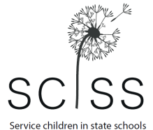Building bridges: a feat of civic engineering
Posted in Views by Philip Dent
Tomorrow, the Service Children's Progression Alliance (quickly, and fondly, coming to be known as the SCiP Alliance), will have its first annual conference.
Building Bridges will bring stakeholders from government, policy, research and practice together to identify the challenges and priorities that will take us from where we are now to a future in which, to quote the SCiP Alliance mission, the children of military personnel make smooth and confident transitions 'into thriving adult lives and careers'.
In keeping with the conference theme, I'm posing a question to the assembled delegates that's pertinent to all of us:
What bridges need to be built to enable thriving lives for Service children?
I have three reflections on this:
First, aiming to realise thriving lives sets an appropriately challenging goal. We start from a situation where four in every ten Service children who could go on to higher education don't (and this is almost half the rate of the general population). But there is also a gap between the prevailing framework of our education system and our vision.
Widening participation, and education policy more generally, has long suffered from too narrow a focus on short-term stages whether GCSE attainment, post-16 participation, or higher education access, retention and success. Even so-called employability goals pertinent to university strategies paint a potentially partial and limited view of human fulfilment. A thriving life goes beyond notions of academic achievement (service children, in general, do as well as their peers at GCSE), sustained employment, or even a fulfilling career, and it is a mission that we take very seriously. This poses a further question:
How can you go beyond the institutional outcomes that drive your day-to-day role to make sure they contribute to thriving adult lives for Service children?
Second, bridges will need to span gaps between people and places. By virtue of the highly mobile lives of some Service children a vast number of people will have a stake in their educational journeys. We need to develop and enhance mechanisms that connect these parents, professionals, and supporters so that their work is complementary and effective in the unique context of service children's lives.
Also, the number of and (in the broadest sense) the distance between the places that a Service child might come to call their educational 'homes' present threats to smooth and confident transitions. I'm keen to see what we can do together to make each child's education journey a meaningful tapestry, rather than a 'rag rug' of experiences.
Finally, we have given significant attention to the research that needs to take place to enable us to understand the context as well as what can be done to bring about positive change sustainably (you can find out more here). We have also been working on developing the practice that makes the difference (it's only what we do differently that will deliver different outcomes) and have set up a practice group to lead future Alliance activity supporting professionals in their work (get in touch if you'd like to know more).
But we also need to think carefully about the gaps between research and practice by developing both, in tandem, from the outset. The research we undertake, the practice developed and delivered, and the policy that shapes the environment in which this happens, must each serve the mission rather than themselves.
Building bridges between where we are and our vision for Service children, between the people and places central their journeys and lives, and between the research, practice and policy that enable the change we want to see each represent a grand feat of civic engineering. We must face the challenges together with the engineer's appreciation of the environment, focus on solutions, and systematic approach to delivery, all in service of our vision for thriving lives.
Tomorrow's conference will signal a call to join this mission as allies in the SCiP Alliance. I invite you to reflect on this shared mission, value your contribution to its achievement, and to get involved.





























